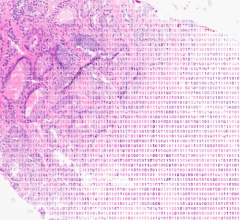December 26, 2007 - Using tiny gold particles embedded with dyes, researchers have shown that they can identify tumors under the skin of a living animal - with the hope of allowing doctors to detect and diagnose cancer earlier and less invasively.
Studded with antibody fragments called ScFv peptides that bind cancer cells, the gold particles grab onto tumors after their injection into a mouse. When illuminated with a laser beam, the tumor-bound particles send back a signal that is specific to the dye, scientists at Emory University and the Georgia Institute of Technology report.
The results appeared online Dec. 23 in the journal Nature Biotechnology and are scheduled for publication in the Jan. 1, 2008 print edition.
"This is a new class of nanotechnology agents for tumor targeting and imaging," said senior author Shuming Nie, Ph.D., a professor in the Wallace H. Coulter Department of Biomedical Engineering at Georgia Tech and Emory University.
Dr. Nie and his collaborators at the Emory/Georgia Tech Cancer Nanotechnology Center of Excellence have been developing light-emitting semiconductor crystals called "quantum dots" into tools for cancer detection and treatment for several years. However, colloidal gold, or gold particles in suspension, offers advantages compared with quantum dots in that the gold appears to be non-toxic and the particles produce a brighter, sharper signal, Dr. Nie says.
"The detail is like a fingerprint, and because of the enhancement provided by the gold surface, the signal from the dye tags is very bright," he said, adding that the distinct peaks in the dye signal mean several different probes could be used at the same time.
“The tags’ rich spectroscopic signatures provide the capability of using several probes at once, but that will require more sophisticated computational tools,” said May Dongmei Wang, Ph.D., assistant professor of biomedical engineering and director of biocomputing and bioinformatics in the cancer nanotechnology center. "We are developing data processing tools and making them available to the National Cancer Institute's caBIG (cancer biomedical informatics grid) so that the research community can use them."
Compared with quantum dots, the gold particles are more than 200 times brighter on a particle-to-particle basis, although they are about 60 times larger by volume. Covered with a non-toxic polymer, the gold particles are about 60-80 nanometers in diameter. That's 150 times smaller than a typical human cell and thousands of times smaller than a human hair.
"I expect that with these probes, it will be possible to detect cancer much earlier, at the microscopic level," said Dong Moon Shin, M.D., associate director of Emory's Winship Cancer Institute and professor of hematology, oncology and otolaryngology. Dr. Shin's laboratory is working with Dr. Nie's to refine the gold particles' use in living animals.
"Even a half-centimeter-wide nodule contains millions of cancer cells, but with this technology we can detect many fewer cells at a time," said Dr. Shin.
In the Nature Biotechnology study, the researchers report that they are able to detect human cancer cells injected into a mouse at a depth of 1-2 centimeters. That makes the gold particles especially appropriate tools for gathering information about head or neck tumors, which tend to be more accessible, Dr. Shin says. The technology will need further adaptation for use with abdominal or lung cancers deep within the body.
The particles described in the study were linked with "single chain variable fragment" (ScFv) antibodies that recognize epidermal growth factor receptor, which is present on the surfaces of many human tumors including head and neck and lung carcinomas.
In the study, antibody-linked particles accumulate in tumors ten times more than particles without antibodies. However, both kinds of nanoparticles tended to accumulate in the liver and spleen over several days, the researchers found.
Dr. Nie says his lab plans to modify the coatings of the nanoparticles to improve tumor targeting. Eventually, he says, the gold particles could also be used to selectively deliver drugs to cancer cells.
For more information: www.bme.gatech.edu


 November 11, 2025
November 11, 2025 








